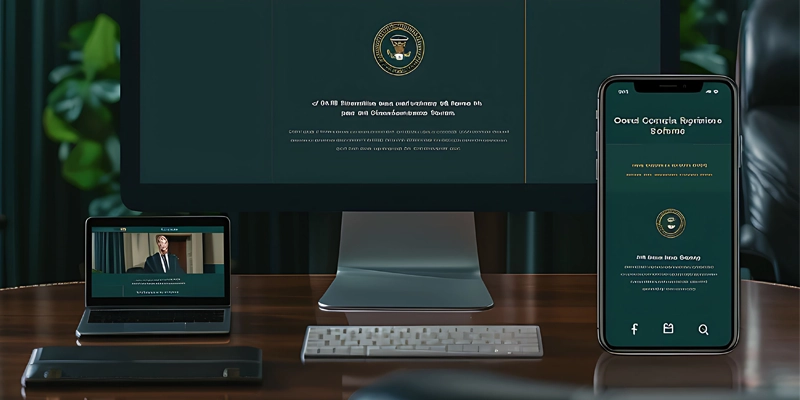Contents
A well-designed solo law firm website is essential in establishing a professional online presence and serves as a potential client’s first point of contact. It communicates credibility, builds trust, and helps distinguish your practice from competitors. This guide will explore critical elements of successful solo law firm websites and offer practical tips to create or enhance your own. Additionally, it introduces RunSensible, a legal practice management software that integrates seamlessly with websites to improve client intake and management processes.
Critical Elements of a Successful Solo Law Firm Website
Clean and Professional Design
A visually appealing website is fundamental for any solo law firm. The design should reflect the firm’s competence and expertise, ensuring that potential clients are met with a polished and trustworthy image. Furthermore, mobile responsiveness is critical, as most website traffic originates from smartphones. A user-friendly interface that performs well across devices will ensure a seamless experience for visitors and encourage them to explore your services further.
Clear and Compelling Messaging
Effective messaging is essential for communicating your firm’s value quickly and concisely. A clear value proposition, supported by a compelling mission statement, should be prominently displayed to immediately inform visitors of what your firm offers and how you can meet their legal needs. Crafting a solid headline and subheading is key to capturing attention; for example, using direct and informative language like “Experienced Estate Planning Attorney Protecting Your Future” creates a focused and persuasive message.
Easy Navigation and User Experience
The structure and navigation of your solo law firm website must facilitate an effortless user experience. Organizing content logically and using clear, intuitive menus will help users find information quickly and efficiently. Additionally, fast loading times are crucial to keeping visitors engaged. At the same time, well-structured content and streamlined navigation will increase the likelihood that potential clients will stay on the site and explore your services further.
High-Quality Content
- Practice Area Pages: Comprehensive and well-structured practice area pages are indispensable for any solo law firm website. These pages should explain the services offered, demonstrate your expertise in specific legal areas, and address standard client concerns.
- Attorney Bio: An attorney bio should be crafted to build trust and establish credibility. Highlighting your experience, education, professional accomplishments, and any memberships in legal associations will reassure visitors of your qualifications.
- Blog Section: Maintaining a blog that covers relevant legal topics can be a powerful tool for showcasing your expertise and keeping your site updated with fresh content. By regularly posting high-quality, informative articles, you not only engage potential clients but also improve your site’s search engine visibility.
Strong Call-to-Actions (CTAs)
Clear and prominent calls-to-action (CTAs) are essential for converting website visitors into clients. CTAs such as “Schedule a Consultation” or “Contact Us Today” guide potential clients toward acting. By integrating RunSensible’s appointment scheduling tools directly into the website, you can streamline the booking process, allowing clients to seamlessly arrange consultations without leaving the site.
Contact Information and Accessibility
Contact information must be easily accessible and visible throughout your website. Providing multiple contact methods, including phone numbers, email addresses, and contact forms, ensures that visitors can choose the most convenient option. Additionally, incorporating accessibility features, such as larger text or compatibility with screen readers, ensures your website is inclusive and compliant with modern web accessibility standards.
By incorporating these key elements, your solo law firm website can effectively and professionally present your practice while enhancing user engagement and client conversion.
SEO Best Practices for Solo Law Firm Websites
Keyword Optimization
Optimizing your solo law firm website with relevant keywords is crucial to improving its visibility in search engine results. Conduct thorough keyword research to identify the terms that potential clients are likely to use when searching for legal services, such as “solo law firm,” “family lawyer,” or “estate planning attorney.” Incorporate these keywords naturally into headings, body content, meta descriptions, and other vital website sections. This strategic placement will enhance your site’s relevance to search engines and increase the likelihood of ranking higher for relevant queries.
Local SEO Strategies
Local SEO plays a significant role in helping solo law firms attract clients from their geographic area. To optimize for local search, claim and complete your Google My Business profile, ensuring that your firm’s name, address, and contact information are accurate and current. Using localized keywords such as “divorce lawyer in New York” throughout your content can also improve your visibility in local search results. Building local citations and gathering positive client reviews are additional strategies to boost your firm’s local SEO. Tools like RunSensible can assist in managing client reviews and facilitating engagement with your local audience, enhancing your firm’s online reputation.
On-Page SEO Essentials
On-page SEO refers to optimizing individual web pages to improve their ranking potential. Key elements include title tags, meta descriptions, header tags, and image alt texts. Each component should be optimized with relevant keywords to ensure that search engines can quickly identify each page’s subject matter. Additionally, using clean and descriptive URLs and proper internal linking helps create a well-structured site that both users and search engines can navigate efficiently.
Content Marketing and Blogging
Content marketing, mainly through blogging, is a powerful way to enhance your website’s SEO. Regularly posting relevant, high-quality blog articles targeting long-tail keywords can attract more traffic to your website. These longer, more specific keyword phrases allow you to address common legal concerns that potential clients may search for, such as “what to do before filing for divorce.” By providing informative content, you establish your firm as a thought leader and increase your chances of ranking for diverse search queries. Regular blogging also ensures that your website is frequently updated with fresh content, a factor that search engines consider when ranking sites.
Adhering to these SEO best practices can improve your solo law firm website’s search engine rankings, attract more relevant traffic, and ultimately convert more visitors into clients.
Case Studies: Solo Law Firm Websites for Inspiration
Law Office of Erin M. Jacobson (Music Industry Law)
The Law Office of Erin M. Jacobson website, branded as The Music Industry Lawyer, is a well-executed example of niche-specific legal branding. The clean, minimalist design communicates professionalism and expertise in the specialized area of music industry law. The site is structured with intuitive navigation, allowing visitors to easily find information about services, client testimonials, and media features. Strong call-to-action (CTA) buttons, such as “Schedule a Consultation,” make it easy for potential clients to engage with the firm. The site is also mobile-responsive, ensuring a seamless experience across devices. However, while the minimalist design is effective, the website could benefit from offering more in-depth content, such as a blog or resources page, to further educate potential clients about specific legal services.
Molly B. Kenny, Family Law (Family Law)
The website for Molly B. Kenny, a family law attorney, effectively balances professionalism with approachability. The calming color scheme and clear layout cater to clients dealing with sensitive legal issues such as divorce and child custody. The site includes valuable content like client testimonials and a regularly updated blog, which helps build trust and authority in the field. Strategic placement of CTAs, such as “Contact Us,” makes it easy for visitors to reach out. However, the site is somewhat text-heavy, and more interactive features, like live chat, could improve engagement. Additionally, simplifying the content into more digestible sections would enhance the user experience, particularly for those looking for quick information.
David J. Shestokas, Constitutional Lawyer (Constitutional Law)
The David J. Shestokas website stands out for its focus on content marketing and education. It offers an extensive range of blog posts, articles, and podcasts that showcase the attorney’s expertise in constitutional law. This wealth of information positions the firm as a knowledgeable authority in its field. The site is easy to navigate, with content organized into clearly defined sections. However, the overall design could benefit from modernization, as it lacks the visual appeal that may engage a broader audience. Additionally, the text-heavy format could overwhelm visitors seeking a quicker, more visual introduction to legal services. Despite these design limitations, the site functions well as an educational resource for clients and the general public.
The Law Office of Kristina Wildeveld & Associates (Criminal Defense)
The website for Kristina Wildeveld & Associates makes an immediate impact with its bold design and strong visuals, reflecting the urgency and professionalism required in criminal defense law. The layout is mobile-friendly and features prominent CTAs like “Get Legal Help Now,” which are designed to drive client engagement. The site also effectively showcases client testimonials and case results, reinforcing the firm’s credibility and success. However, the bold design may not appeal to all users, particularly those seeking a more subdued approach to legal services. Additionally, the website would benefit from more educational content, such as a blog or legal guides, to help potential clients understand their legal options. Overall, the site excels at client conversion through its dynamic design and actionable CTAs.
| Law Firm Website | Function | Pros | Cons |
| Law Office of Erin M. Jacobson (Music Industry Law) | A niche-specific website that communicates expertise in music industry law. Easy navigation and mobile-responsive. | – Clean, minimalist design. – Clear CTAs like “Schedule a Consultation.” – Mobile-responsive. |
– Minimalist design may lack detailed content. – No educational resources or blog for client education. |
| Molly B. Kenny, Family Law (Family Law) | Designed for sensitive family law clients with strong focus on trust-building through testimonials and blog. | – Calming design suited for family law. – Strong CTAs and client engagement. – Regular blog updates. |
– Text-heavy content can overwhelm. – Lacks interactive features like live chat. – Content could be simplified. |
| David J. Shestokas, Constitutional Lawyer (Constitutional Law) | Functions primarily as an educational resource with extensive blogs, articles, and podcasts. | – Extensive content builds authority. – Well-organized layout. – Strong content marketing focus. |
– Outdated design lacks modern visual appeal. – Text-heavy format may overwhelm some users. |
| Kristina Wildeveld & Associates (Criminal Defense) | Bold design focusing on criminal defense services. Strong CTAs and testimonials drive client conversions. | – Bold, engaging design. – Strong CTAs like “Get Legal Help Now.” – Mobile-friendly. – Displays successful case results. |
– Bold design may not appeal to all users. – Lacks educational content (blog or guides). |
Tools and Resources for Building a Solo Law Firm Website
Website Builders and Platforms
When building a solo law firm website, choosing the right platform is critical for balancing functionality and ease of use. Several popular website builders can cater to the needs of solo practitioners:
- WordPress: Known for its flexibility and customization, WordPress is a widely used platform that offers a range of themes and plugins tailored to law firm websites. It requires technical knowledge but allows greater control over design and functionality.
- Squarespace: This platform offers sleek, modern templates that are easy to use and maintain. Squarespace is particularly well-suited for solo practitioners who want a visually appealing website without extensive coding.
- Wix: A user-friendly, drag-and-drop website builder, Wix is ideal for those looking to build a site quickly and with minimal technical expertise. Its extensive app marketplace allows for easy integration of additional tools.
Each platform has pros and cons, with WordPress offering the most control but requiring more maintenance, while Squarespace and Wix offer simplicity and ease of use but with less customization.
Essential Plugins and Tools
To ensure your solo law firm website runs efficiently, it’s essential to incorporate various tools and plugins for critical functions such as SEO, security, and client management.
- SEO Tools: Plugins like Yoast SEO (for WordPress) or Rank Math can help optimize your site’s content for search engines, improving visibility and rankings.
- Security: SSL certificates are non-negotiable for a legal website, ensuring client information remains secure. Additionally, security plugins like Wordfence or iThemes Security (for WordPress) add layers of protection against cyber threats.
- Contact Forms: Contact forms, such as WPForms or Gravity Forms, allow potential clients to contact you, ensuring seamless communication efficiently.
- Client Management: Integrating a client management tool like RunSensible allows solo law firms to streamline client intake, appointment scheduling, and communications directly through the website. RunSensible’s CRM functionality can automate follow-ups, improve client tracking, and enhance workflow efficiency.
- Chatbots and Live Chat: Tools like LiveChat or Tidio can enhance client engagement by providing real-time responses to potential client inquiries, leading to quicker conversions.
Hiring a Professional Designer vs. DIY
Building a website using WordPress, Squarespace, or Wix is a cost-effective option, especially for solo practitioners. These platforms offer customizable templates tailored to your practice’s branding and messaging. However, a do-it-yourself approach may require more polish and functionality than a professionally designed website.
Hiring a professional web designer ensures that your site reflects a high-quality standard tailored to your needs. Designers familiar with the legal industry can help ensure your website complies with ethical standards and includes features that resonate with potential clients. While this route can be more expensive, it often produces a more polished, professional product that better represents your firm.
By choosing the right tools and resources, whether DIY or with professional assistance, you can build a highly functional, aesthetically pleasing solo law firm website that enhances client engagement and supports your practice’s growth.
Common Mistakes to Avoid on Solo Law Firm Websites
Overloading the Website with Information
One of the most common mistakes on solo law firm websites is overwhelming visitors with excessive information. A cluttered design filled with large blocks of text can discourage potential clients from exploring your services. Instead, focus on delivering straightforwardconcise content that communicates your key offerings and expertise without overwhelming users. Organize information into manageable sections with simple headings, bullet points, and clear calls to action (CTAs). This will make it easier for visitors to understand your firm’s services and navigate the website effectively.
Neglecting Mobile Optimization
In today’s digital landscape, mobile optimization is essential. Many potential clients will access your site through smartphones or tablets, and a poorly optimized mobile experience can lead to high bounce rates and lost opportunities. Ensure your solo law firm website is fully responsive, automatically adjusting to different screen sizes and devices. Test your site’s usability on mobile platforms to ensure that navigation, loading speeds, and contact forms work smoothly across all devices. Ignoring mobile optimization can severely limit your site’s effectiveness.
Ignoring Security and Privacy
Security and privacy are paramount for any legal website. A solo law firm website handles sensitive client data, and any security breach can erode trust and lead to legal consequences. Ensure your site has an SSL certificate, ensuring that any data transferred between the user and your site is encrypted. This protects client information and signals to search engines that your site is secure, which can boost your SEO ranking. Implementing secure contact forms and a clear privacy policy are essential to safeguard client data and demonstrate your commitment to protecting their privacy.
Not Updating Content Regularly
Stale, outdated content can harm your search engine rankings and your firm’s credibility. A website that hasn’t been updated in months or years suggests inactivity, which can deter potential clients. Regular updates to your blog, practice area pages, and case studies ensure that your site remains relevant and demonstrates ongoing engagement in your legal practice. Use a content calendar to plan updates, and consider tools like RunSensible to automate reminders for content updates, case milestones, or client follow-ups. Keeping your website fresh with new content helps maintain its relevance and effectiveness in client acquisition.
Avoiding these common mistakes will ensure that your solo law firm website remains professional, secure, and client-focused, enhancing your firm’s online presence and improving client engagement.
Read this blog about best client intake software.
Final Thoughts: Elevate Your Solo Law Firm’s Online Presence
Building a successful solo law firm website requires more than good design; it demands strategic content, smooth functionality, and a client-centered approach. By incorporating clean design, compelling messaging, and user-friendly navigation, your website becomes a powerful tool for attracting and converting potential clients. Combining these elements with robust SEO practices and fresh, high-quality content ensures that your site looks professional and performs well in search results, driving traffic and engagement.
As you create or improve your solo law firm website, avoid common pitfalls like cluttered designs, outdated content, and poor mobile optimization. Tools like RunSensible can streamline client intake, appointment scheduling, and CRM, making your site a seamless extension of your practice. With these strategies in place, your website will enhance your firm’s credibility, efficiency, and ability to attract new clients. Start building your online presence today to set your practice apart from the competition.
Take your solo law firm to the next level with a website that works as hard as you do. Sign up for RunSensible today and seamlessly integrate client management, appointment scheduling, and automated follow-ups into your site. Start your free trial now and experience how our tools can streamline your practice and help you grow your client base.
FAQs:
1. Why is mobile optimization important for my solo law firm website?
Mobile optimization is crucial because a large percentage of users access websites through smartphones or tablets. A mobile-friendly website ensures that your site adapts to different screen sizes and functions smoothly on all devices. This enhances user experience, reduces bounce rates, and increases the chances of converting visitors into clients, especially in local search results.
2. How can I improve the SEO of my solo law firm website?
Improving SEO involves several key steps: conducting keyword research to target relevant terms, optimizing on-page elements like title tags and meta descriptions, and creating high-quality, informative content, such as blog posts or service pages. Additionally, focusing on local SEO through Google My Business and acquiring client reviews can help boost visibility in local search results.
3. What are the essential elements of a successful solo law firm website?
A successful solo law firm website should include a clean and professional design, clear messaging about your services, and strong calls-to-action (CTAs) that guide visitors to take the next step. It should also feature easy navigation, mobile optimization, high-quality content (such as blogs or case studies), and prominently displayed contact information. Integrating client management tools like RunSensible can further streamline client intake and communication
Disclaimer: The content provided on this blog is for informational purposes only and does not constitute legal, financial, or professional advice.








